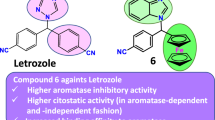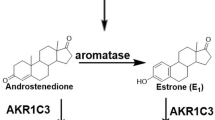Abstract
In searching for potent cancer chemopreventive agents from synthetic or natural products, 28 randomly selected flavonoids were screened for inhibitory effects against partially purified aromatase prepared from human placenta. Over 50% of the flavonoids significantly inhibited aromatase activity, with greatest activity being demonstrated with apigenin (IC50: 0.9 μg/mL), chrysin (IC50: 1.1 μg/mL), and hesperetin (IC50: 1.0 μg/mL).
Similar content being viewed by others
References Cited
Brodie, A. M. H. and Njar, V. C. O.: Aromatase inhibitors and breast cancer.Semin. Oncol., 23, 10–20 (1996).
Conn, P. M. and Crowley, W. F., Gonadotrophin-releasing hormone and its analogues.N. Engl. J. Med., 324, 93–103 (1991).
Harvey, H. A.: Aromatase inhibitors in clinical practice: Current status and a look to the future.Semin. Oncol., 23, Suppl., 9, 33–38 (1996).
Hoffman, P. G., Jones, L. A., Kuhn, R. W. and Sitteri, P. K.: Progesterone receptors: saturation analysis by a solid phase hydroxyapatite adsorption technique.Cancer, 46, 2801–2804 (1980).
Kellis, J. T. Jr. and Vickery, L. E.: Purification and characterization of human placental aromatase cytochrome P-450,J. Biol. Chem., 262, 4413–4420 (1987).
Rabe, T., Rabe, D. and Punnebaum, B.: New aromatase assay and its application for inhibitory studies of aminogluthetimide on microsomes of human term placenta.J. Steroid Biochem., 7, 305–309 (1982).
Santen, R. J., Manni, A. and Harvey, H. A.: Endocrine treatment of breast cancer in women.Endocr. Rev., 11, 221–265 (1990).
Santen, R. J., Martel, J. and Hoagland, M.: Stromal spindle cells contain aromatase in human breast tumors.J. Clin. Endocrinol. Metab., 79, 627–632 (1994).
Siiteri, P. K.: Review of studies on estrogen biosynthesis in the human.Cancer Res., 42, 3269s-3273s (1982).
Thompson, E. A. and Siiteri, P. K.: The involvement of human placental microsomal cytochrome P-450 in aromatization.J. Biol. Chem., 249, 5373–5378 (1974a).
Thompson, E. A. and Siiteri, P. K.: Utilization of oxygen and reduced nicotinamide adenine dinucleotide phosphate by human placental microsomes during aromatization of androstenedione.J. Biol. Chem., 249, 5364–5372 (1974b).
Author information
Authors and Affiliations
Corresponding author
Rights and permissions
About this article
Cite this article
Jeong, H.J., Shin, Y.G., Kim, I.H. et al. Inhibition of aromatase activity by flavonoids. Arch Pharm Res 22, 309–312 (1999). https://doi.org/10.1007/BF02976369
Received:
Issue Date:
DOI: https://doi.org/10.1007/BF02976369




